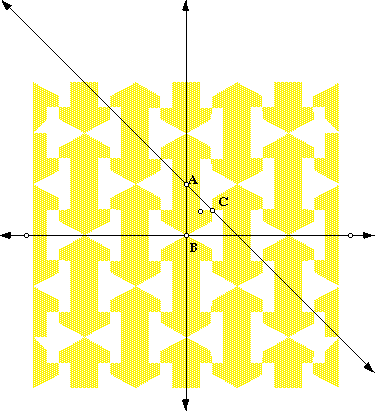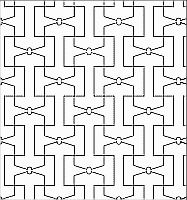![[Woven 3*3]](sym.1.24.gif) Orbifold notation:
3*3
Orbifold notation:
3*3
A three-way crossing point is at the point marked with a red dot.
A three-fold gyration point is at the point marked with a blue dot.
Figure 4
![[Unreal triangles 333]](sym.1.20.gif) Orbifold notation:
333
Orbifold notation:
333
The three types of three-fold gyration points are at the centers of each of the
three different sized gray triangles.
Figure 5
![[Mirror mirror *2222]](reflections.gif) Orbifold notation:
*2222
Orbifold notation:
*2222
The four types of two-way crossing points are (1) near the chin, (2) near the
forehead, (3) near the upper back of the head, and (4) near the lower back
of the head.
Figure 6
![[Woven 22*]](sym.1.19.gif) Orbifold notation:
22*
Orbifold notation:
22*
The two types of two-fold gyration points are at the points
marked with green and red dots.
There is one unique mirror line, which is marked in a couple of places in blue.
Figure 7
![[Woven 4*2]](sym.1.21.gif) Orbifold notation:
4*2
Orbifold notation:
4*2
A four-fold gyration point is at the point marked with a red dot.
A two-way crossing point is at any of the intersections of the blue lines.
Figure 10
![[Triquetras 333]](rotations.gif) Orbifold notation:
333
Orbifold notation:
333
The three types of three-fold gyration points are at (1) the centers of the red
spirals, (2) the centers of the blue spirals, and (3) the center of the
equilateral triangle formed by the centers of three adjacent points of type (1).
![[pi]](pi.gif) /2 radians (180 degrees), and that every
gyration point and kaliedoscopic point in the pattern will be one of
those mentioned above.
/2 radians (180 degrees), and that every
gyration point and kaliedoscopic point in the pattern will be one of
those mentioned above.
Use The Geometer's Sketchpad to generate a picture of your pattern. Clearly label the two different types of kaleidoscopic point and the one type of gyration point.
The figure on the left is from Geometer's Sketchpad (click on it to download the file) and the figure on the right is from Kali. Points A and B are the two different types of kaleidoscopic points and point C is the one type of gyration point.


The ability to connect to and reference pages of others' work is one of the great strengths of hypertext documents. How would you deal with the weaknesses discussed above when producing your own Web pages? What other strengths and weaknesses of hypertext can you think of, and how might you exploit or avoid them in your own work? How can you configure your own Web pages to make them more useful to others who might want to refer to them? You may find yourself needing the answers to these questions when working on your final project!
If a page contains a list of relevent links, then it should contain enough to still be useful a year later when 20% of the links no longer work. The links should also be carefully selected in terms of their predicted reliability. For example, linking to The Math Forum's list of geometry Web sites will probably be reliable, while linking Joe's little gallery of wallpaper may not.Another weakness of the web is that when you make a link to another site, there is more of a possiblity for the, um, "surfer" to get side tracked easily, because those other sites may have other links as well, and so on. A unit should be mostly self-contained but for a small section of "where to go from here." Another way to keep people from straying to far is to make use of certain HTML features, like the part of Netscape "frames" which allows you to put a tag in a hyper-link that will cause a new Web browser to be invoked on the new html page when the link is clicked on.
Navigation links throughout a multipage HTML document are important. Since most Web traffic seems to come from search engines these days, often a person is thrown into the middle of a document without knowing what big picture of what they are looking at. "Up" or "Top" links are essential. "Next" and "Previous" links are helpful, though not as essential.
The top page should be short and to the point. Choices of where to go to from the top page should be limited to probably about seven, and the decision about which choice to make (which link to follow) should be obvious (that's the goal, anyway).